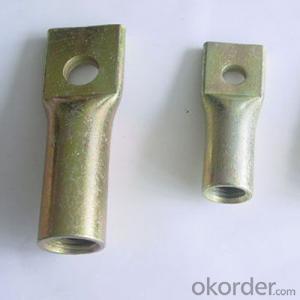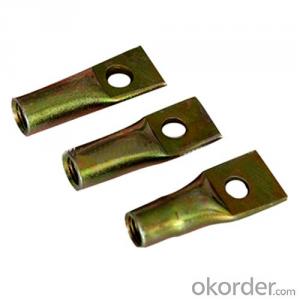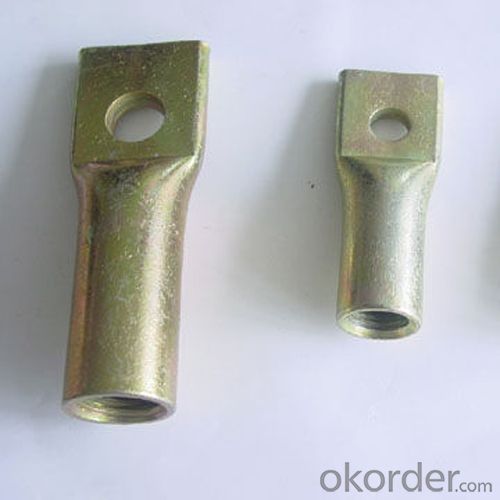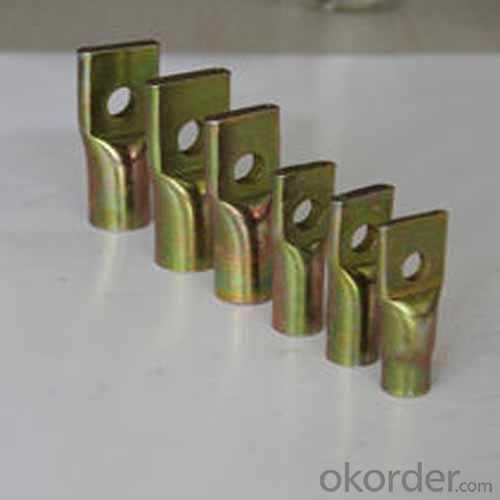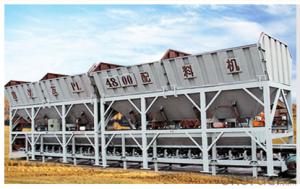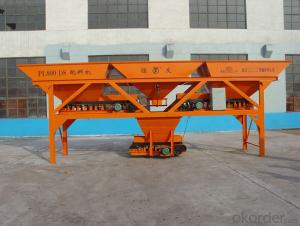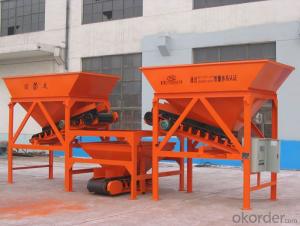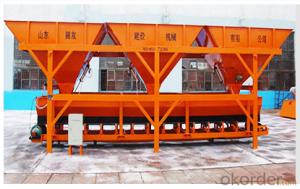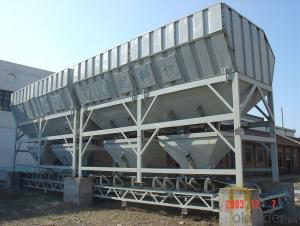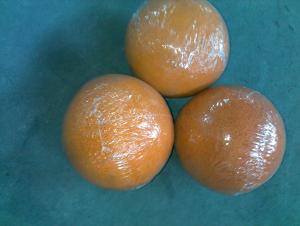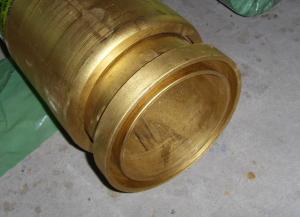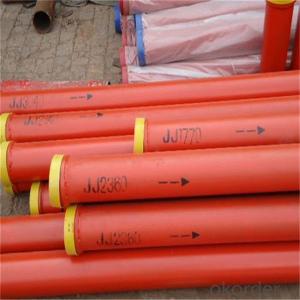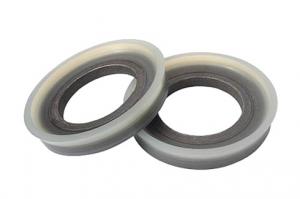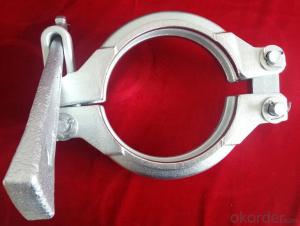Precast Concrete Transport Socket with CE and ISO 9001 Certificates
- Loading Port:
- Tianjin
- Payment Terms:
- TT OR LC
- Min Order Qty:
- 100 pc
- Supply Capability:
- 10000 pc/month
OKorder Service Pledge
OKorder Financial Service
You Might Also Like
1. Specifications:
Thread M/RD 12-52 transport socket
3-4 times lifting capacity
Testing before shipment
Provide test certificate
M/RD 12-36
2. Features:
1) Product: lifting socket, lifting insert, bend and waved socket, transport socket, flat socket, socket with bar and more
2) Diameter: M/RD 12-36mm
3) Length: 40-200mm
4) Capacity: 0.5-12.5MT
5) Material: stainless 304/316, ST52.3
6) Surface: plain, galvanized
3. Packing and delivery
Packaging details: tranport socket be packed in cartons, then put on steel plates
Delivery lead time: within 25 days after confirming the order
4. Primary competitive advantages:
1) More than 10 years focus on building material manufacturing
2) Prompt delivery time within 25 days after confirming order
3) Eathu's products are enhanced by the QA and quality control checks during the production; if necessary each order can be send out with a certificate referring back to test
4) Precast concrete elements may be lifted several times after casting and during storage and erection-by using this system, the designer and the worker manager ensure that each lift is carried out safely and quickly
· Experienced Staff
· Form A
· Guarantee/Warranty
· Packaging
· Price
· Product Features
· Product Performance
· Prompt Delivery
· Quality Approvals
· Reputation
· Service
· Small Orders Accepted
· More than 10 Years Experience
· Testing before shipping
Market:
Asia
Australasia
Central/South America
Mid East/Africa
North America
Western Europe
FAQ:
Q1: How long about delivery time Concrete transport socket ?
A1: The delivery time will be very short, normally we keep the raw materials for old customers and sometime we also keep stock products to
make sure delivery time in any emergency cases.
Q2: How do we guarantee the quality of our Concrete transport socket ?
A2: We have established an advanced quality management system which conducts strict quality tests at every step, from raw materials to the final product. At the same time, we provide extensive follow-up service assurances as required.
Q3: How soon can we receive the product after purchase?
A3: Within three days of placing an order, we will book the vessel for goods. The specific shipping date is dependent upon international and government factors, but is typically 7 to 30 workdays.
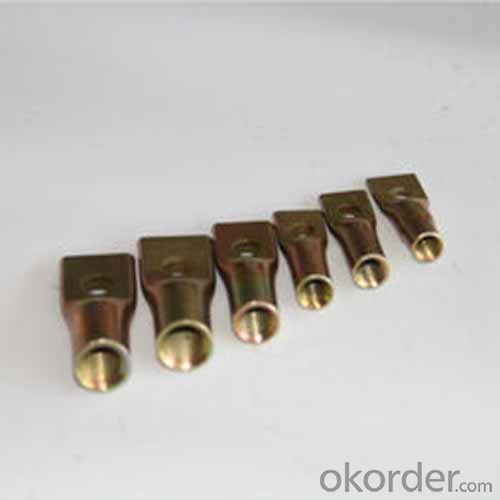
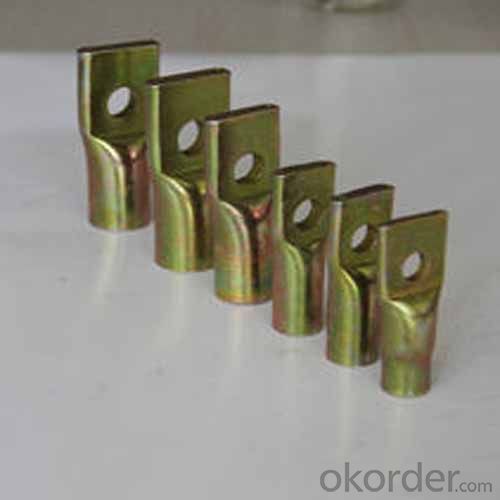
- Q: Are there any cost-effective alternatives to original concrete pump spare parts?
- Indeed, there exist cost-effective alternatives to the original spare parts for concrete pumps. One possibility is to contemplate acquiring aftermarket parts, which are frequently manufactured by third-party producers. These components are engineered to meet identical specifications and criteria as the original parts, yet they are commonly obtainable at a reduced price. Another avenue to explore is the acquisition of used or refurbished parts. These parts have previously been employed but have been refurbished to function flawlessly, presenting a more economical substitute for new parts. Nevertheless, it is crucial to verify that these alternatives are obtained from trustworthy suppliers to guarantee quality and compatibility with the particular model of your concrete pump.
- Q: How can one ensure compatibility between concrete pump spare parts and the pump?
- Ensuring compatibility between concrete pump spare parts and the pump is crucial to maintain the efficiency and performance of the equipment. Here are a few steps to ensure compatibility: 1. Identify the correct model and manufacturer: Gather all the necessary information about the concrete pump, including the model number and manufacturer. This information will help you find the right spare parts that are specifically designed for that particular pump model. 2. Use genuine spare parts: It is always recommended to use genuine spare parts provided by the pump manufacturer or authorized distributors. Genuine parts are specifically designed and tested to meet the pump's specifications, ensuring a perfect fit and compatibility. 3. Check part numbers and specifications: Before purchasing any spare parts, carefully cross-check the part numbers and specifications with the original parts. This will help ensure that the new parts are compatible with the pump. 4. Consult with experts: If you are unsure about the compatibility of certain spare parts, consult with experts or the manufacturer's technical support team. They can provide guidance and advice based on their expertise and experience. 5. Conduct regular maintenance and inspections: Regularly inspect and maintain the concrete pump to identify any wear or damage to the parts. This will help you identify the specific spare parts that need replacement and ensure compatibility with the pump. 6. Prioritize quality and reliability: While cost may be a factor, it is important to prioritize quality and reliability when choosing spare parts. Investing in high-quality parts will ensure better performance, durability, and compatibility with the pump. By following these steps, you can ensure compatibility between concrete pump spare parts and the pump, thereby maximizing its lifespan, performance, and overall efficiency.
- Q: How often should hopper cylinders be inspected or replaced in a concrete pump?
- To ensure optimal performance and prevent potential malfunctions, it is essential to regularly inspect hopper cylinders in a concrete pump. The frequency of inspections and replacements depends on various factors, such as usage intensity, the type of concrete being pumped, and the overall condition of the equipment. As a general recommendation, it is advised to inspect hopper cylinders at least once a month or after every 100 hours of operation, whichever comes first. During these inspections, thoroughly examine the cylinders for any indications of wear, corrosion, or damage. Additionally, check the functioning of the seals, gaskets, and other components connected to the cylinders. Nevertheless, it is crucial to note that the inspection frequency may need to be increased if the pumped concrete contains abrasive materials or if the pump operates in harsh environmental conditions. In such situations, more frequent inspections and replacements may be necessary to prevent unexpected breakdowns and costly repairs. Ultimately, the objective is to maintain the hopper cylinders in a good state and promptly address any issues. Regular inspections, along with routine maintenance and proper cleaning, can significantly extend the lifespan of the cylinders and ensure the concrete pump operates efficiently and safely.
- Q: How do I find the right part number for a specific concrete pump spare part?
- To find the right part number for a specific concrete pump spare part, there are a few steps you can follow: 1. Identify the specific part you need: First, determine the exact part you are looking for. This could be a specific component or a replacement part for a particular area of the concrete pump. 2. Consult the equipment manual: Check the equipment manual or documentation that came with the concrete pump. The manual often includes a parts list or diagram, which can help you identify the part number you need. 3. Contact the manufacturer or supplier: Reach out to the manufacturer or supplier of the concrete pump to inquire about the specific part you require. Provide them with the make, model, and serial number of the pump, as well as a detailed description or photograph of the part if possible. They should be able to provide you with the correct part number and any additional information you may need. 4. Use online resources: Utilize online resources such as manufacturer websites, spare parts catalogs, or specialized equipment platforms. These platforms often have search functions where you can input the make and model of the concrete pump to find the corresponding part numbers. 5. Seek assistance from industry experts: If you are still unable to find the right part number, consider reaching out to industry experts or professionals who specialize in concrete pump equipment. They may have the knowledge and experience to help you identify the correct part number based on your specific needs. Remember to double-check the part number provided by the manufacturer or supplier to ensure accuracy before making any purchases. Additionally, it is advisable to keep a record of the part number for future reference in case you need to reorder or replace the part again.
- Q: Can concrete pump spare parts be repaired or refurbished?
- Yes, concrete pump spare parts can be repaired or refurbished if they are damaged or worn out. This can help extend their lifespan and save costs compared to purchasing new parts.
- Q: How does a hopper vibrator prevent concrete blockages?
- A hopper vibrator is a mechanical device designed to prevent concrete blockages in construction equipment, such as concrete pumps and mixers. It works by applying vibrations to the hopper, which is the large container where the concrete is stored before it is poured or transferred. The main reason concrete blockages occur is due to the tendency of the material to settle and become compacted, especially when it is stored for a long time or during transportation. This can lead to clogging and obstruction of the flow of concrete, slowing down the construction process and potentially causing damage to the equipment. By using a hopper vibrator, the vibrations are transmitted to the concrete within the hopper, effectively preventing it from settling and compacting. The vibrations create a loosening effect on the concrete particles, ensuring that they remain in a more fluid state. This allows for a continuous and smooth flow of concrete, preventing any blockages or obstructions from occurring. Additionally, the vibrations from the hopper vibrator also help to dislodge any potential blockages that may have already formed. The shaking motion can break up clumps of concrete or other debris that might be blocking the flow, allowing for uninterrupted movement of the material. Overall, a hopper vibrator is an essential tool in construction equipment as it helps to maintain a consistent flow of concrete, preventing blockages and ensuring the smooth and efficient operation of the construction process.
- Q: How can I extend the lifespan of my concrete pump spare parts?
- There are several ways to extend the lifespan of your concrete pump spare parts. 1. Regular maintenance: Develop a maintenance schedule and stick to it. This includes cleaning, lubricating, and inspecting the parts for any signs of wear or damage. Replace any worn-out parts promptly to prevent further damage. 2. Proper storage: Store your spare parts in a clean and dry environment to prevent rust and corrosion. Keep them away from moisture, extreme temperatures, and direct sunlight. 3. Use quality parts: Invest in high-quality spare parts from reputable manufacturers. These parts are usually more durable and have a longer lifespan compared to cheaper alternatives. 4. Follow manufacturer guidelines: Always follow the manufacturer's guidelines for operating and maintaining your concrete pump. This ensures that you use the spare parts correctly and minimize the risk of premature wear. 5. Train operators: Properly train your operators on the correct usage and handling of the concrete pump and its spare parts. This reduces the chances of accidental damage caused by improper operation. By implementing these practices, you can significantly extend the lifespan of your concrete pump spare parts and maximize their performance and efficiency.
- Q: Can I use alternative materials for concrete pump spare parts?
- Yes, it is possible to use alternative materials for concrete pump spare parts. However, it is important to consider the specific requirements and performance characteristics of the parts before making any substitutions. Concrete pump spare parts are designed to withstand high pressures and abrasive materials, so using alternative materials that can withstand these conditions is crucial. It is recommended to consult with the manufacturer or a professional in the field to ensure that the alternative materials chosen will not compromise the performance or safety of the concrete pump.
- Q: How long does it take to replace a specific concrete pump spare part?
- The time it takes to replace a specific concrete pump spare part can vary depending on factors such as the complexity of the part, availability of the replacement, and the experience of the technician. Generally, it can take anywhere from a few hours to a few days for the replacement process to be completed.
- Q: How can a malfunctioning control panel affect the pump's operation?
- A malfunctioning control panel can have various negative impacts on the operation of a pump. Firstly, the control panel is responsible for monitoring and controlling the pump's functions, such as starting, stopping, and regulating the flow of fluids. If the control panel malfunctions, it may fail to send accurate signals to the pump, leading to erratic or incorrect operation. Additionally, a malfunctioning control panel can result in a loss of communication between the pump and other components or systems. For instance, if the control panel fails to relay important information to the pump's sensors or other control devices, it may not be able to react appropriately to changes in pressure, temperature, or flow rate. This can lead to inefficient performance, potential damage to the pump, or even complete failure. Furthermore, a malfunctioning control panel may also impact the safety of the pump's operation. Control panels often incorporate safety features like emergency shutdowns or alarms to prevent hazardous situations. If these safety mechanisms are compromised due to a malfunction, it can increase the risk of accidents, equipment damage, or even harm to personnel. In summary, a malfunctioning control panel can disrupt the proper functioning of a pump by causing operational inconsistencies, loss of communication with other components, decreased efficiency, increased risk of accidents, and potential damage to the pump itself. Therefore, it is crucial to regularly inspect and maintain control panels to ensure their proper functioning and minimize the chances of any negative impact on the pump's operation.
Send your message to us
Precast Concrete Transport Socket with CE and ISO 9001 Certificates
- Loading Port:
- Tianjin
- Payment Terms:
- TT OR LC
- Min Order Qty:
- 100 pc
- Supply Capability:
- 10000 pc/month
OKorder Service Pledge
OKorder Financial Service
Similar products
Hot products
Hot Searches
Related keywords
